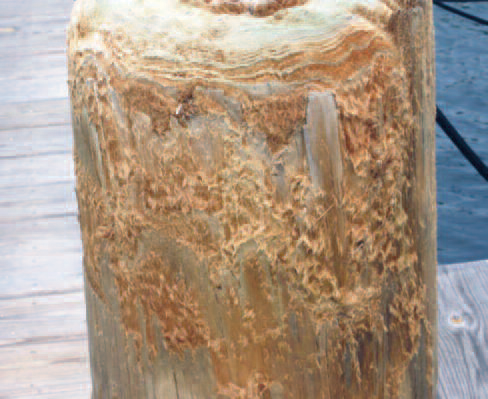Salt Killed Wood in Marine Structures

msucares.com
Known for its inherent durability and chemical resistance capabilities, wood is an undeniable and relied upon structural building material. However, like other structural building materials, wood needs to be treated to protect it from naturally occurring degradation properties. These degrading properties include biological, mechanical, and chemical.
Consequently, when it comes to wood preservation, the most common treatments primarily target the biological decaying factors that affect wood. Factors such as marine wood borers, wood rot, termites, and other known organisms that are prone to causing wood degradation. And while biological preservative treatments work well to prevent organisms from causing marine structures to fall into disrepair, they don’t do much to prevent the damage incurred by chemical degradation. This is because unless the wood preservative is oil based or specifically engineered to be water repellent, the wood treatment won’t prevent or reduce the amount of chemicals the wood absorbs.
Chemical Degradation in Water
In relevance to marine applications, chemical degradation is primarily caused by saltwater’s high salinity. Under certain conditions, saltwater containing the chemical compound NaCl, also known as Sodium Chloride, will leave a powdery white residue on marine pilings as the water comes into contact with the pilings. The powdery residue that is left behind is most often chlorine, and overtime this chlorinated residue will absorb into the wood piling; thus, damaging its lignin structure. As a result, this leaves the wood piling with a surface that looks “fuzzy” or “stringy.” These abnormal surfaces are telltale signs that the wood could be subject to eventually fail without repair. How quickly this happens to a marine structure’s pilings depends on the type of wood piling that was used and its permeability. Furthermore, chemical deterioration can be accelerated by pressure washing, sunlight, and rough waves.
Solutions & Preventatives
1. If possible, treat the wood with a creosote or oil based preservative to repel and prevent salt water from leaving behind soluble residues. The treatment should be applied to the wood or pilings before the wood is affected with salt kill. Once the wood is salt killed, the treatments will only protect the surface and not the interior of the wood that will inevitably continue to deteriorate.
2. High-temperature kiln drying can reduce susceptibility to salt kill by closing pits in the wood, thus making the wood less permeable to the water.
3. Utilize vinyl piling and materials for marine structures. Vinyl marine materials have a higher resistance to saltwater intrusion than wood does, and it’s generally engineered to last longer than wood used in water; treated or not. This makes vinyl a great material to build with as it helps to both protect and prolong the life of a great financial investment such as a dock, pier, or other marine structures..
Lastly, it’s important to recognize the difference in chemical deterioration and biological deterioration. Knowing the difference will allow for project engineering to choose the right type of wood or material being used, and also the type of treatment that may be needed for prevention or repair.
Learn Even More About Pressure Treated Wood
Visit our page about Pressure Treated Lumber to learn even more about its benefits, or go ahead and contact us online or call (800) 816-0335 to get a quote.
